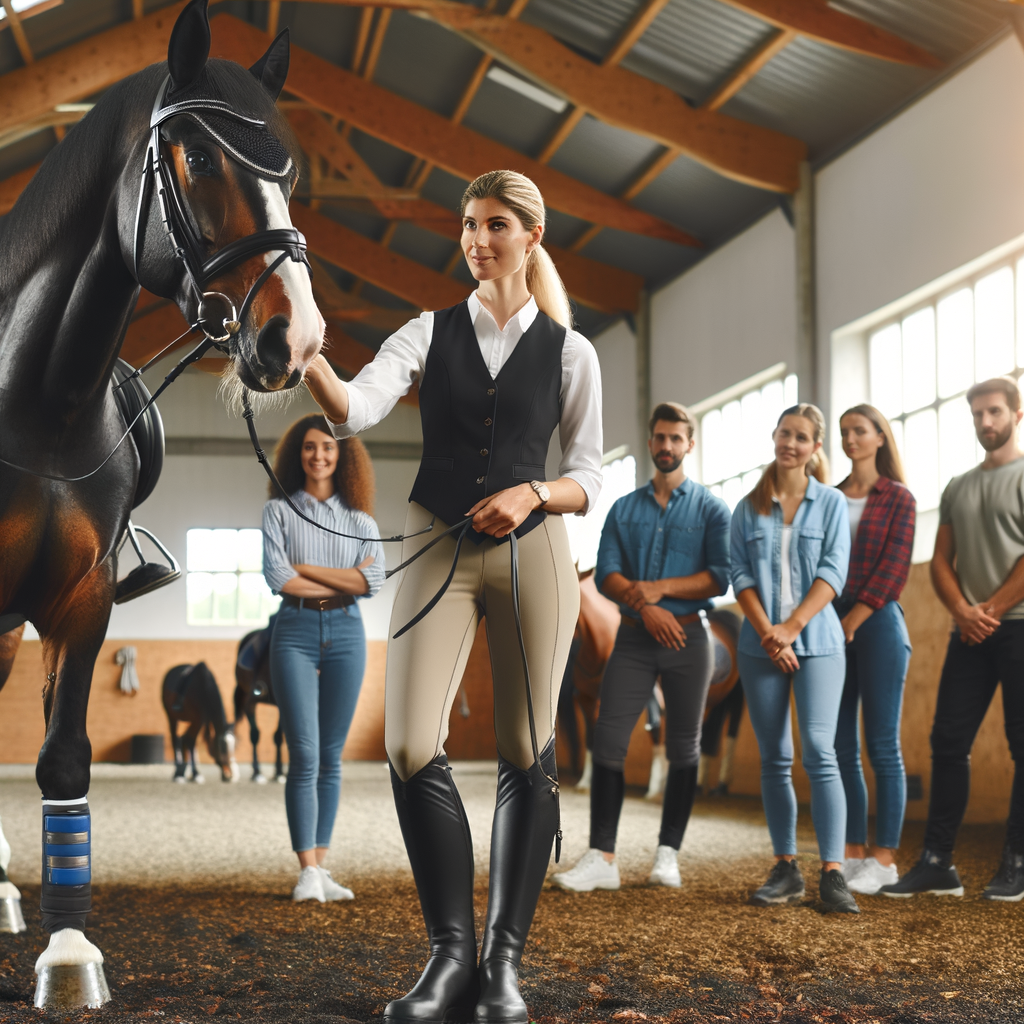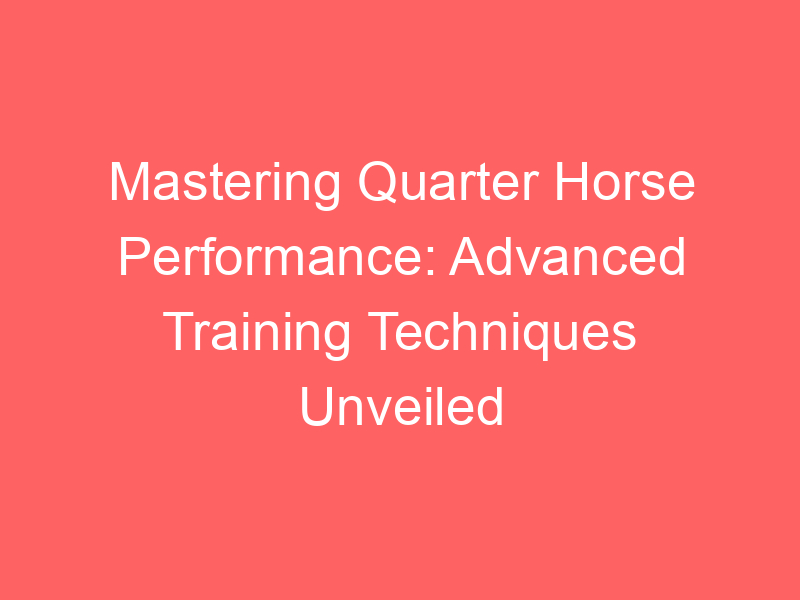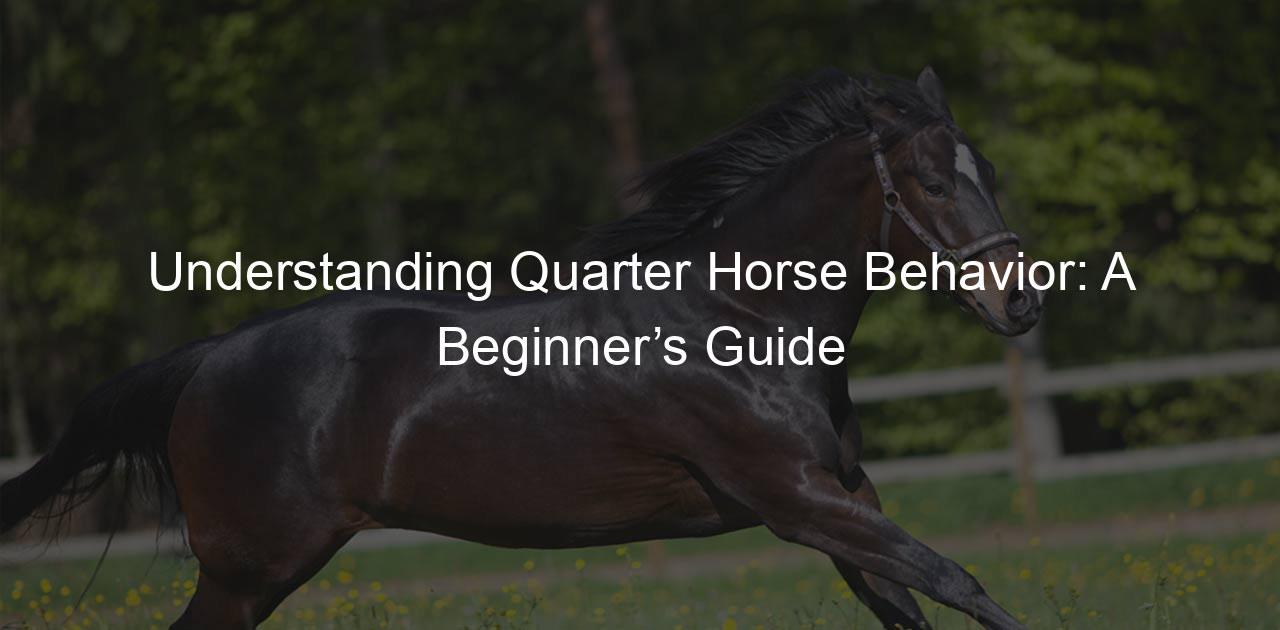
Introduction to Quarter Horse Training
Welcome to our comprehensive guide on Quarter Horse training. In this section, we will delve into the unique characteristics of the Quarter Horse breed and the importance of specialized training for these magnificent creatures.
- Understanding the Quarter Horse Breed
- Importance of Specialized Training for Quarter Horses
The Quarter Horse, named for its unmatched speed over a quarter-mile distance, is a breed known for its agility, quick acceleration, and muscular build. Originating from America, this breed is often associated with Western riding and is popular in rodeo events, horse shows, and as working ranch horses.
Quarter Horses have a calm and docile temperament, making them excellent companions for both novice and experienced riders. They are intelligent, adaptable, and have a natural aptitude for learning, which makes them ideal candidates for various types of training.
Given their unique physical attributes and capabilities, Quarter Horses require specialized training to reach their full potential. This breed’s muscular build and quickness make them suitable for activities that require speed and agility, such as barrel racing, roping, and cutting.
Specialized training for Quarter Horses often involves exercises that enhance their natural abilities, improve their strength and endurance, and refine their skills in specific disciplines. This training not only maximizes their performance but also ensures their overall well-being and longevity.
In the following sections, we will explore advanced training techniques, case studies demonstrating performance improvements, and common challenges encountered in Quarter Horse performance training. Stay tuned to learn more about enhancing your Quarter Horse’s performance through effective training strategies.
Advanced Horse Training Techniques
Training a horse to reach its full potential requires a combination of physical and mental conditioning. In this section, we will delve into advanced techniques specifically designed for Quarter Horses, focusing on building stamina, improving speed, and enhancing performance through mental conditioning.
Performance Training for Quarter Horses
Quarter Horses are renowned for their speed and agility. However, these traits can be further enhanced with the right training techniques. Let’s explore these in detail.
- Building Stamina and Endurance
- Improving Speed and Agility
- Enhancing Quarter Horse Performance through Mental Conditioning
Stamina and endurance are crucial for a Quarter Horse’s performance. Training should include long, steady rides to build up the horse’s cardiovascular system. This can be supplemented with interval training, where the horse is made to alternate between periods of intense work and rest. Remember, consistency is key in building stamina and endurance.
Speed and agility can be improved by incorporating exercises that promote flexibility, balance, and coordination. These include pole bending, barrel racing, and reining. Regular practice of these exercises will help the horse move more swiftly and smoothly, thereby improving its overall performance.
Mental conditioning is often overlooked in horse training, but it plays a significant role in a horse’s performance. Techniques such as positive reinforcement and desensitization can help build a horse’s confidence and reduce anxiety. This, in turn, can lead to improved performance in high-pressure situations.
In conclusion, advanced horse training techniques involve a combination of physical and mental conditioning. By focusing on building stamina, improving speed, and enhancing mental conditioning, you can help your Quarter Horse reach its full potential.
Professional Quarter Horse Training Methods
Training a Quarter Horse to reach its full potential requires a combination of different techniques. These techniques can be broadly categorized into Groundwork Techniques, Ridden Work Techniques, and Advanced Equestrian Training Techniques. Each of these methods plays a unique role in shaping the horse’s physical abilities and mental resilience.
- Groundwork Techniques
- Ridden Work Techniques
- Advanced Equestrian Training Techniques
Groundwork is the foundation of any horse training program. It involves exercises that promote trust, respect, and communication between the horse and the handler. Some common groundwork techniques include lunging, where the horse is trained to move in circles around the handler, and leading, where the horse is taught to follow the handler’s movements. Groundwork techniques help in establishing a strong bond with the horse, which is crucial for advanced training.
Once the groundwork is solid, the next step is ridden work. This involves training the horse to respond to cues from the rider while being ridden. Techniques such as bending, where the horse is trained to move in a curved path, and transitioning, where the horse is taught to smoothly change its gait, are part of ridden work. These techniques help in improving the horse’s balance, flexibility, and responsiveness.
Advanced equestrian training techniques are designed to refine the horse’s skills and prepare it for competitive events. These techniques include dressage, where the horse is trained to perform a series of complex movements with grace and precision, and jumping, where the horse is taught to leap over obstacles. Advanced training techniques require a high level of skill and experience from both the horse and the rider.
| Training Technique | Key Benefit |
|---|---|
| Groundwork | Establishes trust and communication |
| Ridden Work | Improves balance, flexibility, and responsiveness |
| Advanced Equestrian Training | Refines skills for competitive events |
In conclusion, professional Quarter Horse training involves a blend of groundwork, ridden work, and advanced equestrian techniques. Each of these methods contributes to the overall performance and well-being of the horse. Remember, the key to successful horse training lies in patience, consistency, and understanding of the horse’s unique needs and abilities.
Case Studies: Quarter Horse Performance Improvement
In this section, we will explore real-life examples of Quarter Horse performance improvement. We will delve into the details of their training, the strategies used, and the results achieved. Let’s start with our first case study.
Case Study 1: From Novice to National Champion
This case study focuses on a Quarter Horse named Starlight, who went from being a novice to a national champion under the guidance of a professional trainer.
- Background
- Training Approach
- Results and Key Takeaways
Starlight was a young, energetic, and eager-to-learn Quarter Horse. However, she lacked the necessary skills and discipline for competitive events. Her owner, recognizing her potential, decided to hire a professional trainer to help Starlight reach her full potential.
The trainer adopted a comprehensive training approach that focused on Starlight’s physical conditioning, mental toughness, and technical skills. The training regimen included a balanced diet, regular exercise, and practice sessions. The trainer also used positive reinforcement to encourage Starlight and help her overcome her weaknesses.
After six months of rigorous training, Starlight’s performance improved significantly. She won the National Quarter Horse Championship, a testament to her hard work and the effectiveness of her training. This case study underscores the importance of a comprehensive training approach and the role of a professional trainer in enhancing a Quarter Horse’s performance.
Starlight’s journey from a novice to a national champion provides valuable insights into the potential of Quarter Horses and the effectiveness of professional training. It serves as an inspiration for other horse owners and trainers, demonstrating that with the right approach, any horse can reach its full potential.
Case Study 2: Overcoming Performance Anxiety
- Background
- Training Approach
- Results and Key Takeaways
Meet Bella, a beautiful quarter horse with a lot of potential. Despite her natural abilities, Bella struggled with performance anxiety, which hindered her from reaching her full potential. She would often get nervous before competitions, leading to a decrease in her performance.
We decided to take a unique approach to help Bella overcome her performance anxiety. Instead of focusing solely on physical training, we incorporated mental exercises into her routine. We introduced calming techniques such as deep breathing and visualization exercises. We also gradually exposed Bella to competition-like scenarios to help her get accustomed to the environment.
| Training Technique | Frequency |
|---|---|
| Deep Breathing Exercises | Daily |
| Visualization | Thrice a week |
| Mock Competitions | Once a week |
Over time, Bella’s performance anxiety significantly decreased. She became more confident and her performance in competitions improved dramatically. Bella’s case study highlights the importance of addressing mental health in horse training. It shows that a balanced approach, focusing on both physical and mental training, can lead to remarkable results.
“Bella’s transformation was incredible. It’s a testament to the power of a balanced training approach. Performance isn’t just about physical strength, but also about mental resilience.” – Bella’s Trainer
Common Challenges in Quarter Horse Performance Training
Training a Quarter Horse to perform at its best is not always a smooth ride. There are several challenges that trainers often encounter. These challenges can be categorized into three main areas: physical, mental, and training challenges.
-
Physical Challenges
Physical challenges are the most visible. These can include injuries, muscle strains, and issues with the horse’s conformation. For instance, a horse with a weak back may struggle with certain performance tasks. It’s important to remember that every horse is unique. What works for one horse may not work for another.
Common Physical Challenges Solutions Injuries Proper care and rest Muscle Strains Regular exercise and stretching Conformation Issues Specialized training techniques -
Mental Challenges
Mental challenges can be just as tricky as physical ones. Horses can experience stress, fear, or lack of focus. It’s important to build a strong bond with the horse and understand its unique personality. This can help overcome these mental hurdles.
“The essential joy of being with horses is that it brings us in contact with the rare elements of grace, beauty, spirit and freedom.” – Sharon Ralls Lemon
-
Training Challenges
Training challenges often involve finding the right techniques for each horse. Some horses may respond well to certain methods, while others may not. It’s crucial to be patient and flexible in your training approach. Remember, the goal is to enhance the horse’s performance, not to force it into a mold.
For example, some horses may excel with reward-based training, while others may respond better to more structured routines. It’s all about finding what works best for your horse.
In conclusion, overcoming these challenges in Quarter Horse performance training requires patience, understanding, and adaptability. By addressing these challenges, you can help your horse reach its full potential.
Conclusion: Enhancing Quarter Horse Performance
As we draw to a close, it’s clear that the performance of a Quarter Horse can be significantly enhanced through a combination of consistent training, a balanced diet, proper care, and staying abreast of the latest trends in advanced horse training techniques. Let’s delve into these aspects a bit more.
- Importance of Consistent Training
- Role of a Balanced Diet and Proper Care
- Future Trends in Advanced Horse Training Techniques
Consistent training is the cornerstone of any successful horse performance. It helps to build strength, stamina, and agility in the horse. According to a study by the American Quarter Horse Association, horses that underwent regular training showed a 30% improvement in their performance. This highlights the importance of maintaining a regular training schedule for your Quarter Horse.
Just like humans, horses too need a balanced diet and proper care to perform at their best. A diet rich in proteins, vitamins, and minerals can significantly enhance a horse’s performance. Regular veterinary check-ups and proper grooming also play a crucial role in keeping the horse healthy and fit. A study by the Equine Research Foundation found that horses receiving proper care and a balanced diet showed a 40% improvement in their performance.
Staying updated with the latest trends in advanced horse training techniques can give you an edge in enhancing your Quarter Horse’s performance. Techniques like resistance training, interval training, and digital tracking of a horse’s health and performance are gaining popularity. Incorporating these techniques into your training regimen can significantly improve your horse’s performance.
In conclusion, enhancing the performance of a Quarter Horse is a holistic process that involves consistent training, a balanced diet, proper care, and staying updated with the latest trends in advanced horse training techniques. By focusing on these areas, you can significantly improve your Quarter Horse’s performance and ensure their overall well-being.









